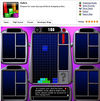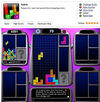From Hard Drop Tetris Wiki
|
Multris | |
|---|---|

| |
| Developer(s) | Viktor Lidholt Ville Hansson |
| Publisher(s) | |
| Release Date(s) | 2000, canceled 2013 |
| Platform(s) | Java |
|
Gameplay Info | |
| Next pieces | 1 |
| Playfield dimensions | 10w x 20h |
| Hold piece | No |
| Hard drop | Yes |
| Rotation system | SRS-like, right-handed, vertically spawning |
| Has 180 rotation | {{{180}}} |
| Adjustable tuning | {{{tuning}}} |
| Garbage attack type | {{{garbage}}} |
| Garbage blocking type | {{{blocking}}} |
| Website | {{{website}}} |
 |

|
Multris was a Java based browser game with both multiplayer and singleplayer. Multris had a unique multiplayer concept and was the only Tetris client with automated tournaments. It started at Multris.com in the year 2000. In 2003, the creators moved it over to Spogg.com, a small social network with some more multiplayer games. Eventually Spogg - and with it Multris - was closed in March 2013. As of now, multris.com is for sale, while spogg.com redirects to a hotel website, but it still has a list of multiplayer games.
Gameplay
Gameplay felt like that of a classic Tetris game: one Preview, no Hold, no Ghost piece, no Wall kicks, memoryless Randomizer (totally random piece sequence). Each room could contain up to 5 players. Like in Tetris Battle, a game lasted a fixed amount of time; usually 10 minutes. The goal was to have the highest score at the end of a game. Points were rewarded by placing pieces (+10 points per piece) and clearing lines:
- Single: 100 points
- Double: 300 points (green smiley worth 1 garbage line)
- Triple: 600 points (blue smiley worth 2 garbage lines)
- Tetris: 1000 points (red smiley worth 3 garbage lines)
Clearing multiple lines at once, also spawned a smiley which could send garbage lines over to the leader or player of choice. However, these lines were send to the owner, if the smiley was not used or cleared within 10 seconds. Each garbage line had its hole on a random column, so garbage was pretty messy. A topped out player lost a fourth (25%) of his current score and restarted with an empty field.
Modes
There were 2 modes:
- Mean: garbage system as described above
- Nice: scoring as above, but no smileys/garbage
Nice was the better choice for singleplayer, especially for entering the weekly and all-time leaderboards. For both modes, 10 minute games was the standard. People could create private rooms with a length of 5, 10 or 20 minutes.
Automated Tournaments
Once in a while (at first 2 times a week; later on multiple times a day) there were automated tournaments. Players just had to enter shortly before the tournament started; the rest was fully automated. Players were divided into different rooms with up to 4 players each. The best 2 players of each room advanced to the next round (resp. the best player in a 2 player room). Eliminated players were still allowed to spectate and chat. Each round lasted 6 minutes.
External links
This article is a Hard Drop Tetris Wiki stub.
You can help Hard Drop Tetris Wiki by expanding it.